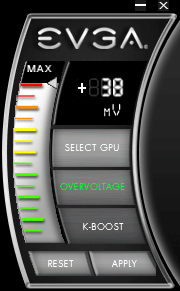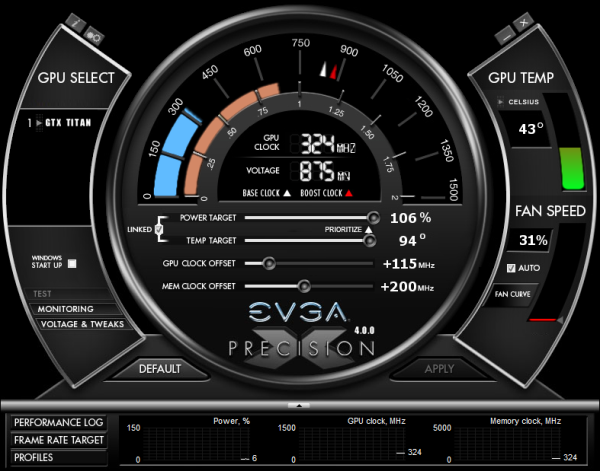NVIDIA’s GeForce GTX Titan Review, Part 2: Titan's Performance Unveiled
by Ryan Smith & Rahul Garg on February 21, 2013 9:00 AM ESTThe Final Word On Overclocking
Before we jump into our performance breakdown, I wanted to take a few minutes to write a bit of a feature follow-up to our overclocking coverage from Tuesday. Since we couldn’t reveal performance numbers at the time – and quite honestly we hadn’t even finished evaluating Titan – we couldn’t give you the complete story on Titan. So some clarification is in order.
On Tuesday we discussed how Titan reintroduces overvolting for NVIDIA products, but now with additional details from NVIDIA along with our own performance data we have the complete picture, and overclockers will want to pay close attention. NVIDIA may be reintroducing overvolting, but it may not be quite what many of us were first thinking.
First and foremost, Titan still has a hard TDP limit, just like GTX 680 cards. Titan cannot and will not cross this limit, as it’s built into the firmware of the card and essentially enforced by NVIDIA through their agreements with their partners. This TDP limit is 106% of Titan’s base TDP of 250W, or 265W. No matter what you throw at Titan or how you cool it, it will not let itself pull more than 265W sustained.
Compared to the GTX 680 this is both good news and bad news. The good news is that with NVIDIA having done away with the pesky concept of target power versus TDP, the entire process is much simpler; the power target will tell you exactly what the card will pull up to on a percentage basis, with no need to know about their separate power targets or their importance. Furthermore with the ability to focus just on just TDP, NVIDIA didn’t set their power limits on Titan nearly as conservatively as they did on GTX 680.
The bad news is that while GTX 680 shipped with a max power target of 132%, Titan is again only 106%. Once you do hit that TDP limit you only have 6% (15W) more to go, and that’s it. Titan essentially has more headroom out of the box, but it will have less headroom for making adjustments. So hardcore overclockers dreaming of slamming 400W through Titan will come away disappointed, though it goes without saying that Titan’s power delivery system was never designed for that in the first place. All indications are that NVIDIA built Titan’s power delivery system for around 265W, and that’s exactly what buyers will get.
Second, let’s talk about overvolting. What we didn’t realize on Tuesday but realize now is that overvolting as implemented in Titan is not overvolting in the traditional sense, and practically speaking I doubt too many hardcore overclockers will even recognize it as overvolting. What we mean by this is that overvolting was not implemented as a direct control system as it was on past generation cards, or even the NVIDIA-nixed cards like the MSI Lightning or EVGA Classified.
Overvolting is instead a set of two additional turbo clock bins, above and beyond Titan’s default top bin. On our sample the top bin is 1.1625v, which corresponds to a 992MHz core clock. Overvolting Titan to 1.2 means unlocking two more bins: 1006MHz @ 1.175v, and 1019MHz @ 1.2v. Or put another way, overvolting on Titan involves unlocking only another 27MHz in performance.

These two bins are in the strictest sense overvolting – NVIDIA doesn’t believe voltages over 1.1625v on Titan will meet their longevity standards, so using them is still very much going to reduce the lifespan of a Titan card – but it’s probably not the kind of direct control overvolting hardcore overclockers were expecting. The end result is that with Titan there’s simply no option to slap on another 0.05v – 0.1v in order to squeak out another 100MHz or so. You can trade longevity for the potential to get another 27MHz, but that’s it.
Ultimately, this means that overvolting as implemented on Titan cannot be used to improve the clockspeeds attainable through the use of the offset clock functionality NVIDIA provides. In the case of our sample it peters out after +115MHz offset without overvolting, and it peters out after +115MHz offset with overvolting. The only difference is that we gain access to a further 27MHz when we have the thermal and power headroom available to hit the necessary bins.
| GeForce GTX Titan Clockspeed Bins | |||
| Clockspeed | Voltage | ||
| 1019MHz | 1.2v | ||
| 1006MHz | 1.175v | ||
| 992MHz | 1.1625v | ||
| 979MHz | 1.15v | ||
| 966MHz | 1.137v | ||
| 953MHz | 1.125v | ||
| 940MHz | 1.112v | ||
| 927MHz | 1.1v | ||
| 914MHz | 1.087v | ||
| 901MHz | 1.075v | ||
| 888MHz | 1.062v | ||
| 875MHz | 1.05v | ||
| 862MHz | 1.037v | ||
| 849MHz | 1.025v | ||
| 836MHz | 1.012v | ||
Finally, as with the GTX 680 and GTX 690, NVIDIA will be keeping tight control over what Asus, EVGA, and their other partners release. Those partners will have the option to release Titan cards with factory overclocks and Titan cards with different coolers (i.e. water blocks), but they won’t be able to expose direct voltage control or ship parts with higher voltages. Nor for that matter will they be able to create Titan cards with significantly different designs (i.e. more VRM phases); every Titan card will be a variant on the reference design.
This is essentially no different than how the GTX 690 was handled, but I think it’s something that’s important to note before anyone with dreams of big overclocks throws down $999 on a Titan card. To be clear, GPU Boost 2.0 is a significant improvement in the entire power/thermal management process compared to GPU Boost 1.0, and this kind of control means that no one needs to be concerned with blowing up their video card (accidentally or otherwise), but it’s a system that comes with gains and losses. So overclockers will want to pay close attention to what they’re getting into with GPU Boost 2.0 and Titan, and what they can and cannot do with the card.











337 Comments
View All Comments
rcabor - Thursday, February 21, 2013 - link
Why is the voltage higher at 996MHz to 992MHz? Is that a typo?rcabor - Thursday, February 21, 2013 - link
meant 966 MHz not 996 MHzRyan Smith - Thursday, February 21, 2013 - link
Bingo. Fixed. Thank you.=)HollyDOL - Thursday, February 21, 2013 - link
Hi,it seems a typo sneaked at voltages mentioned (page 2) at the three working frequencies tightly below 1GHz speed... should say 1.1625 (I guess) but says 1.625V for example. 1.625 also appears in text, not just the table.
just4U - Thursday, February 21, 2013 - link
I am interested in these luxury coolers for some of their lower end GPU's. I don't know what they cost but I'd pay a premium for it if it wasn't to far out there..BrokenCrayons - Thursday, February 21, 2013 - link
Viewed outside fo consideration for the cost, it's quite impressive. Inexpensive (relatively) GPU compute seems like its focus which makes sense given the original design intentions. On the gaming side of the equation, the performance benefits don't stack well against the costs. A 680 or 7970 seems like a much more reasonable purchase unless the whole intention is for fairly pointless bragging rights to people that don't care, won't understand the significance, or are just random sorts you ramble to on the Internet about how much money you can afford to drop on a GPU which only returns the ability to waste time playing games at higher end display settings. So yeah, the performance is interesting, but the price puts it firmly into the "yeah whatever" territory of gaming.-BC
Hood6558 - Thursday, February 21, 2013 - link
This is another piece of the puzzle I call my Ultimate Dream Machine, in which every component is the best or fastest available. It joins such parts as the i7-3970X, Asrock X79 Extreme11, Corsair 900D, Corsair Dominator Platinum 64 GB kits, and Corsair AX 1200i. I'll probably never have the money to build it, but that's okay, the dream is sometimes better than the reality. Anyway by the time I build it all the above parts will be obsolete, slow museum pieces, and the new stuff will be 10 times faster.silverblue - Thursday, February 21, 2013 - link
What's going on with the 7970's framerate in Crysis: Warhead's 1080p E Shaders/G Quality tests? It's massively behind the 7970GE.Also, the minimum framerate table for Crysis: Warhead appears to have been placed on top of the Far Cry 3 page in addition to the bottom of the Crysis: Warhead page.
Ryan Smith - Thursday, February 21, 2013 - link
I'll have to look into that and get back to you. It's not a transcription error, so it may have been a configuration error on the benchmark.JlHADJOE - Thursday, February 21, 2013 - link
1/3 FP64 is awesome. This is a bargain if you need the compute.If you wanna play games on it... not so much. =P